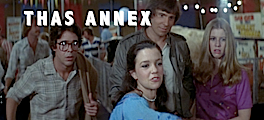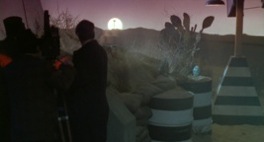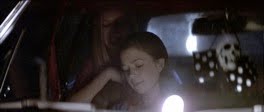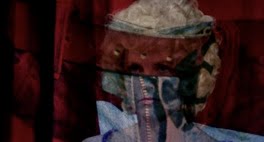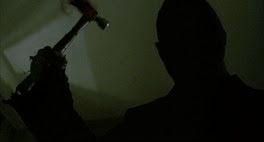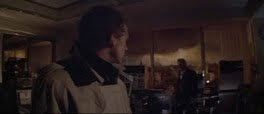Spielberg films, even at their most superb, are rarely slow and hardly subtle. The motions he makes are usually set-up for extreme emphasis, overt animation, or an emotional or adrenaline button-push. His films move in a way, and with the visual sensibility, of a comic book - panels and events rushing by in flourishes of action editing and graphical pointedness.
Hooper, on the other hand, is a comparatively subdued, minimalist and mannerist filmmaker. His construction of scenes is hushed and unhurried, slow and uniform. Many of his motions are quite extraneous to narrative/dramatic checklisting (instead they serve aesthetically, and manifest feeling and theme in a more abstracted - less event-based - way). The way his films move is alongside the slow, elegant crawl of his camera, pace determined by the languor of the filming eye (one that really soaks in the textures it finds in front of it) -- not the zing of a graphic edit or frames composed to a maximum of spectacle or pop tonality.
Spielberg's directing is very much about goofy zest and dynamism. Beat by beat, or shot by shot, he constructs - along lines of strong narrative and dramatic function - to the utmost of snappy movement and energy and blunt emotional affect.
Hooper's directing is very much about grace and a very formal musicality. Not beat by beat, but within whole phrases, he constructs - with a unique disengagement from obvious narrative and dramatic purposes - to the utmost flow of the single, flowing visuo-melodic phrase, and to an overall patience, found in an oxymoronic "intricate minimalism": that which does not bend itself over backwards to achieve the blunt, or quirky, or hyper effect, but instead luxuriates in unabashed, intricate aestheticism, finding further patience and a valuable artistic seriousness in its strength of subtlety.
To distill this difference in a specific directorial characteristic, it can be put to this: Spielberg is very much not a long-take director, and he does not direct around - that is, in avoidance of - coverage and editing. That is not to say he does not use these elements masterfully, nor that he does not execute some expert single takes, but just that he does not have the inclination to willfully avoid them in the creation of rarefied set-pieces. Hooper very much is a long-take director, and he does actively direct around - in avoidance of - the need of extensive, scene-accessing coverage and editing (as has been pored over in this blog, Hooper accesses scenes not from a literalistic vantage, but from an abstract one where often distance and non-access is the formal method and point) -- and Poltergeist is very much of a long-holding and perspectival, slow and drawn-out camera, a camera that moves and shifts in its space with an utter steadiness and patience (and it comes to characterize the entire film with a patient and hushed quality).
Did you realize...
that the scene in 'Poltergeist' where Tangina (played by Zelda Rubenstein) has the Freelings (played by JoBeth Williams and Craig T. Nelson) make contact with Carol Anne in the upstairs hallway in preparation for the rescue mission is one complete, uninterrupted, elaborately dollying shot? (This stylistic approach - that of the "moving master" shot - is very common in Orson Welles films.)
that 'Poltergeist' actually consists of two other scenes that can be seen as companion long-take sequences (despite not being total cases, as the scene mentioned above so distinguishably is), all three tied together by their each involving characters engaged in dialogue with the camera foreground (representing engagement with psychic or ethereal realms - thus these are three formally united scenes in the film, in which characters approaching the camera becomes a concerted visual motif for otherworldly communication)? These will be labeled below as Scene #2 - the scene in which Tangina is introduced in the downstairs living room, and the skeptical Steven Freeling tries to communicate with her psychically; and Scene #3 - the scene looked at in this post, where Diane first makes contact with Carol Anne through the TV (although not being a one-shot scene at all, it contains a series of shots that utilize the long-take, moving master principles: continuous takes consisting of a moving camera, elaborately re-conforming the positions of the characters within the frame through its continuous, shifting motion).
#1

that 'Poltergeist' actually consists of two other scenes that can be seen as companion long-take sequences (despite not being total cases, as the scene mentioned above so distinguishably is), all three tied together by their each involving characters engaged in dialogue with the camera foreground (representing engagement with psychic or ethereal realms - thus these are three formally united scenes in the film, in which characters approaching the camera becomes a concerted visual motif for otherworldly communication)? These will be labeled below as Scene #2 - the scene in which Tangina is introduced in the downstairs living room, and the skeptical Steven Freeling tries to communicate with her psychically; and Scene #3 - the scene looked at in this post, where Diane first makes contact with Carol Anne through the TV (although not being a one-shot scene at all, it contains a series of shots that utilize the long-take, moving master principles: continuous takes consisting of a moving camera, elaborately re-conforming the positions of the characters within the frame through its continuous, shifting motion).
#1
Steve and Diane Beckon the Voice of Carol Anne
A Complete Long Take
In this scene, the camera moves to ten different positions in one single roaming take, responding to the movements of the characters and remarkably creating ten different arrangements for the mise en scene. These are marked (1)-(10), and the idea here is that no cuts are made between them:
(1) A Complete Long Take
In this scene, the camera moves to ten different positions in one single roaming take, responding to the movements of the characters and remarkably creating ten different arrangements for the mise en scene. These are marked (1)-(10), and the idea here is that no cuts are made between them:

#2
Steven Tries to Test Tangina
This scene has the camera move to six different positions within one single roaming take, reconfiguring its framing in accordance with the moving, rearranging characters. These are marked (1)-(6), and the idea here is that no cuts are made between them:Steven Tries to Test Tangina
























































































